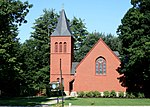Trinity Church (Holderness, New Hampshire)
18th-century churches in the United StatesChurches completed in 1797Churches in Grafton County, New HampshireChurches on the National Register of Historic Places in New HampshireHolderness, New Hampshire ... and 1 more
National Register of Historic Places in Grafton County, New Hampshire

Trinity Church is a historic Episcopal church, located in a small cemetery on New Hampshire Route 175 in Holderness, New Hampshire. Built in 1797, it is one of only two surviving 18th-century buildings in the state that was built as a church (the other is the Union Church in Claremont). It is also the only major surviving structure associated with the life of Samuel Livermore, a prominent New Hampshire statesman and jurist. The church was listed on the National Register of Historic Places in 1984. It is maintained by the cemetery's association, and is occasionally used for services.
Excerpt from the Wikipedia article Trinity Church (Holderness, New Hampshire) (License: CC BY-SA 3.0, Authors, Images).Trinity Church (Holderness, New Hampshire)
North Holderness Road,
Geographical coordinates (GPS) Address External links Nearby Places Show on map
Geographical coordinates (GPS)
| Latitude | Longitude |
|---|---|
| N 43.756666666667 ° | E -71.669722222222 ° |
Address
Trinity Church
North Holderness Road
03245
New Hampshire, United States
Open on Google Maps








